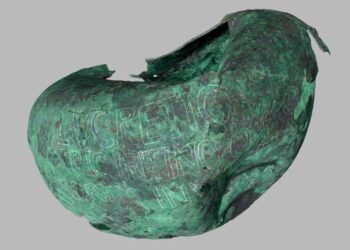A recent study from Tel Aviv University has put forth a new hypothesis regarding the presence of children in prehistoric cave art sites. Earlier, it was believed by scholars that children accompanied adults into deep caves to learn cultural traditions. But according to a team of archaeologists, these children could have played a more spiritual role as mediators between the human and supernatural realms.

Archaeological records hold evidence of the presence of children as young as two years old in the labyrinthine depths of caves, which were full of prehistoric art. Dr. Ella Assaf, Dr. Yafit Kedar, and Prof. Ran Barkai of Tel Aviv University, whose research was published in the journal Arts, point to the existence of children’s footprints, handprints, and even finger paintings alongside adult hand and footprints in caves throughout Europe, primarily in France and Spain. This is seen at sites such as Basura Cave in Italy, where 14,000-year-old footprints of at least two children were discovered deep within the cave, and Rouffignac Cave in France, where a child younger than five appears to have drawn part of the saiga antelope painting.
These findings pose a basic question: Why were young children brought into such dangerous and oxygen-depleted environments? Venturing into these caves meant crawling through tight spaces, descending shafts, and enduring almost complete darkness. The conventional explanation has been that these experiences formed part of an educational process, enabling children to learn about the art and culture of their community. However, researchers at Tel Aviv University offer another explanation.
According to this study, many ancient societies viewed caves as sacred portals to the underworld. These deep places were considered locations for shamanic rituals where early humans tried to communicate with cosmic entities or spirits of their ancestors. In this regard, children were viewed as liminal beings—entities that straddled the boundary between the human world and the spiritual world.

“Many indigenous cultures worldwide, throughout history and prehistory, have viewed children as ‘active agents’—mediators between this world and the entities inhabiting the natural world, the underworld, and the cosmos as a whole,” explains Dr. Assaf.
According to the researchers, similar practices were followed by indigenous societies in Australia, the San culture of the Kalahari Desert, and among the Maya and Inca civilizations, where children were an integral part of spiritual communication rituals.
This theory aligns with evidence from indigenous societies where children take part in vision quests, trance-healing ceremonies, and rites of passage. In some traditions, they are seen to have a natural ability to perceive and interact with spiritual forces more readily than adults.
Another possible contributor to the mystical experience of prehistoric cave people could have been hypoxia—low oxygen levels caused by torches and poor ventilation deep underground. Some researchers propose that hallucinations and altered states of consciousness caused by oxygen deprivation may have influenced the perceptions of early humans and made them feel closer to supernatural entities.
The study highlights that most Paleolithic cave paintings contain geometric patterns and depictions of animals, while plant or landscape paintings are rare. This focus on symbolic imagery reflects a ritualistic purpose rather than purely artistic expression.
The findings of Assaf, Kedar, and Barkai contrast with the conventional theories of childhood during the Paleolithic era. If their hypothesis is correct, then children were not merely passive learners but were actively engaged and played an important role in their societies’ cosmology. Their presence in the caves might have served a dual purpose: ensuring spiritual harmony while also training them for future leadership positions in their communities.























